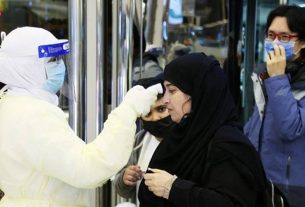Thu 02 July 2020:
The Middle East faces a “critical threshold” amid a relaxation of coronavirus measures following a surge in cases in the region, the World Health Organization warned on Wednesday.
The global health body confirmed there were more than one million cases of the COVID-19 disease across the 22 countries that the WHO’s Eastern Mediterranean region covers, stretching from Morocco to Pakistan.
According to figures published by the global health body on Wednesday, the 22 countries from Morocco to Pakistan had recorded 1,077,706 novel coronavirus cases and 24,973 deaths
“We are at a critical threshold in our region,” the WHO’s Middle East head Ahmed al-Mandhari said in an online press conference.
More than 80 percent of all deaths in the region were reported in five countries: Egypt, Iran, Iraq, Pakistan and Saudi Arabia, according to the WHO.
Al-Mandhari said it was a “concerning milestone”.
“The number of cases reported in June alone is higher than the total number of cases reported during the four months following the first reported case in the Region on 29 January,” he said.
Iran, which has been struggling to contain the Middle East’s deadliest outbreak, on Monday recorded its highest single-day COVID death toll of 162.
It now has a recorded a total of 230,211 infections and 10,958 deaths.
In neighbouring Iraq, authorities have refused to reimpose strict lockdown measures, even as hospitals across the country, battered by years of war, have been swamped in recent weeks.
While the virus had spread relatively slowly for months, on Wednesday the number of recorded cases surpassed 51,000 including more than 2,000 deaths.
Egypt, the Arab world’s most populous country with 100 million inhabitants, has officially reported 68,000 cases and around 3,000 deaths from the COVID-19 disease.
Lebanon, battling an economic crisis and public unrest alongside the novel coronavirus, reopened the Beirut airport after months of closure.
The small eastern Mediterranean state has recorded some of the lowest infection and mortality rates in the Middle East: 1,800 cases and just 34 deaths.
In contrast, neighbouring Israel saw a jump of about 15 percent in case numbers in the last week to over 25,500 on Wednesday, according to government figures.
The West Bank too was hit by a sharp spike in infections, with the Palestinian Authority on Wednesday announcing a five-day lockdown across the territory.
Total confirmed coronavirus infections in the territory more than doubled within a week to 2,636 following the easing of previous restrictions.
In Qatar, residents cautiously returned to beaches on Wednesday as the Gulf nation, with one of the world’s highest per-capita infection rates and tough penalties for failing to wear masks in public, continued to reopen.
Its neighbour Saudi Arabia has been the hardest-hit Gulf state, recording more than 194,225 infections and 1,700 deaths.
‘Social responsibilities’
Al-Mandhari attributed the rise in cases to increased testing, but also to the lifting in recent weeks of restrictions put in place to combat the virus’s spread.
He urged individuals to be “cautious and vigilant” as lockdowns and curfews were eased, and to follow protocols recommended by health authorities.
“Easing of lockdowns does not mean easing of the response or easing of social responsibilities,” said al-Mandhari, adding there was a risk the number of cases will rise as public spaces reopen “even in countries where the situation now seems to be stabilising”.
He called for global solidarity in the face of the pandemic, urging countries to “strengthen” their healthcare systems.
Other WHO officials who participated in the meeting said Middle East governments needed to exert more efforts in preparing intensive care unit beds and emergency wards.
Photo Courtesy: SPAregions
Think your friends would be interested? Share this story!





